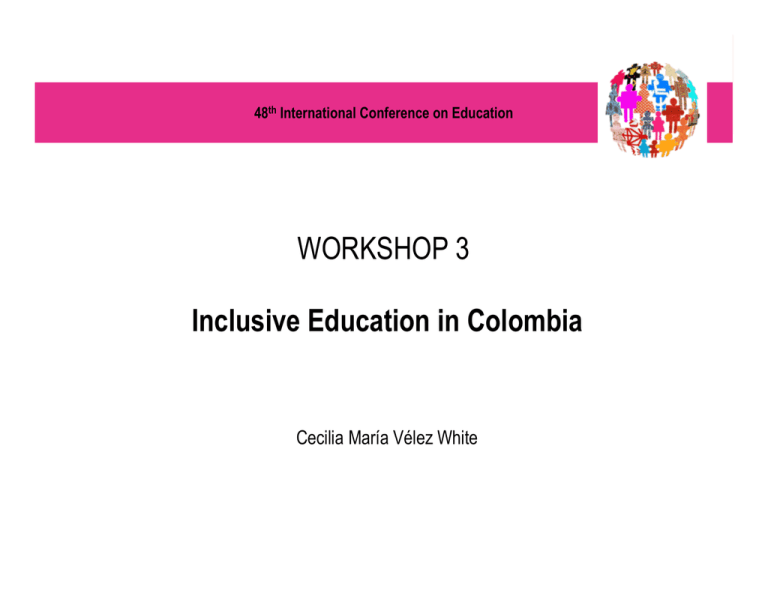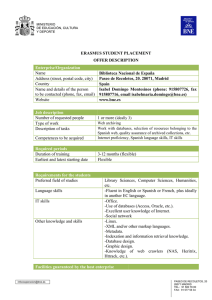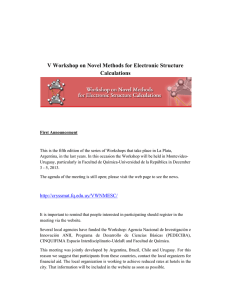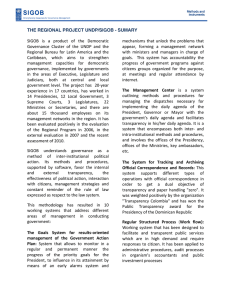Inclusive Education in Colombia - International Bureau of Education
Anuncio

Ministerio de Educación Nacional República de Colombia 48th International Conference on Education WORKSHOP 3 Inclusive Education in Colombia Cecilia María Vélez White Ministerio de Educación Nacional República de Colombia Ministry of Education of Colombia Republic of Colombia Ministerio de Educación Nacional República de Colombia 1. INDIGENOUS COMMUNITIES Indigenous enrollment 2007 2008* 319.619 332.749 Indigenous Population according to census 2005* 407.689 78,40% Gross Enrollment (estimated / Population census 2005) ENROLLMENT 450,000 400,000 350,000 300,000 250,000 407,689 332,749 319,619 200,000 150,000 100,000 50,000 0 407,689 81.62% 78.40% Indígenas 2007 Población indígena según CENSO 2005* Cobertura bruta (estimada s/ Población CENSO 2005) 2008* 81,62% Ministerio de Educación Nacional República de Colombia Inclusion Strategies To characterize the population Enrollment TO ORGANIZE a pertinent Educational offer Quality TO ENHANCE educational management: •Pedagogical Approach •Teachers’ training •Suitable Didactic Material Efficiency 9To achieve access and permanence of all students in the educational system. TO IMPROVE The teaching and learning environment Ministerio de Educación Nacional República de Colombia ETHNIC GROUPS • 85 Indigenous communities • 14 Linguistic varieties (65 speakers of other languages) • 2 African communities with languages Universidad de los Andes. CCLA Arawak Quechua Bora Tupi Caribe Independientes Chibcha Tukano Chocó Witoto Guahibo Saliba Maku Criollos: Palenque y Creole Ministerio de Educación Nacional República de Colombia THE EDUCATIVE PROJECT An ethno-educational project is: : A conceptual, pedagogical, methodological and operational guide of the educational processes chosen by an ethnical group. Features: 9 It is framed in the life project of an ethnical group and develops its educational component. 9 It is a process of social participation and cooperative decision-making. It recognizes their tradition, knowledge, science, technology and culture. 9 It includes the intercultural aspects relevant to the development of their educational process. 9 It defines its linguistic policies. 9 It implements a social perspective in the planning of future educational processes. 9 It guides Secretariats of Education in the provision of the educational service to these communities. Ministerio de Educación Nacional República de Colombia Update until 2008 and projection for 2010 Advancement Number of ethnical and educational projects Projects promoted by the Ministry of Education for 2008. 25 Autonomous Educational Projects for 2008 15 New Projects to be implemented for 2010 37 Total number of projects that are going to be supported 77 Ministerio de Educación Nacional República de Colombia 2. POPULATION WITH DISABILITES 2006 2007 2008* Enrollment 80.510 82.346 101.375 Gross enrollment (estimated according to census 2005) 14,73% 15,07% 18,55% Population with disabilities feasible to include according to census 2005* 546.431 101.375 82.346 80.510 18.55% 14.73% 15.07% Total población atendida con NEE 2006 2007 2008* In accordance with the 2005 Colombian National Census, the population with disabilities reach 6.4% (2.518.963) of the total. 546.431 of them could be included in the system (between 5 and 16 years old), which means a covering of 19% in 2008. Ministerio de Educación Nacional República de Colombia INSTITUTIONS AND PEDAGOGICAL APPROACH Population Secretariats of Education Schools Teachers Students Special educational needs 79 4.369 11.943 101.375 Pedagogical Approach 9Legislation for the organization of the service provision. 9Provision of schools with pertinent materials. 9Training of teachers in inclusive education and in the teaching of reading, writing and mathematics. Ministerio de Educación Nacional República de Colombia 3. POPULATION IN CONDITION OF DISPLACEMENT 350.000 324.266 300.000 250.000 211.222 213.726 200.000 150.000 100.000 50.000 0 Between 2007 and 2008, the population between the ages of 5 and 7 identified in SIPOD increased from 437.911 to 527.520 and the enrollment of this population went from 49% to 61%. Atención a población en situación desplazamiento 2006 2007 2008 Fuente: Acción Social y Ministerio de Educación Nacional Cruce SIPOD - R-166 con corte al 31 de Agosto de 2008. 9In 2008 the enrollment rate of children and young people between 5-17 is 324.266, while the total enrollment number is 415.849. Ministerio de Educación Nacional República de Colombia INSTITUTIONAL AND PEDAGOGICAL APPROACH Population Displaced communities Secretariats of Education Teachers Students 65 19.643 415.849 Pedagogical Approach: 9Flexible educational models are implemented: • Three groups: Children, young people and adults. • The institution’s educational project is incorporated into the model. • Teachers are trained. • Provision of didactic materials. • Evaluation and follow-up strategies Ministerio de Educación Nacional República de Colombia 4. RURAL POPULATION Growth 17,1% 2.700.000 2.600.000 2.500.000 2.400.000 2.300.000 2.561.843 2.608.280 2.640.029 2007 2008 2.200.000 2.100.000 2.254.295 2.000.000 2002 2006 Evolution of Rural Enrollment 2002-2008 Ministerio de Educación Nacional República de Colombia INSTITUTIONAL AND PEDAGOGICAL APPROACH Population Rural population Secretariats of Education Schools Teachers 27 3.240 27.183 Pedagogical Approach 9The pedagogical flexible models are teaching approaches that suited to the needs of rural areas and put the student at the center of the education process. Pre-school Accelerated learning Escuela nueva Postsecundary Telesecundary SER SAT Upper secondary Ministerio de Educación Nacional República de Colombia 5. ILLITERATE AND ADULT POPULATION 2006 2007 (Cycle 1) 2005-2008 676.468 2008* 230.000 250.000 202.478 200.000 151.244 827.246 people have been taught to read and write since 2002 . 150.000 100.000 50.000 0 Ciclo 1 Catering of young people and adults in other cycles Cycles 2-6 2005 2006 2007 443.563 558.825 604.115 2008* 517.770 According to the population census (2005) the illiterate young and adult population (15 years or more) makes up to the 9.6% of the total population (2’756.230 citizens).





